The Bigness Complex, Urbanism and the Florida Market
------
reprinted from December 2006
------
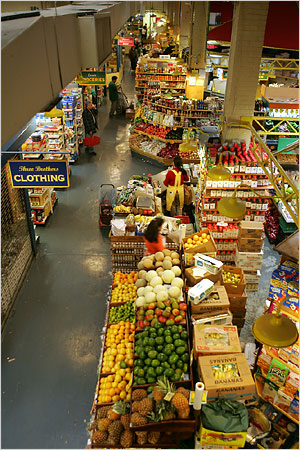
Tony Cenicola/The New York Times. FIORELLO'S PLACE The Essex Street Market has sold vegetables to immigrants and hipsters alike since 1940.
Despite the article in the Sunday New York Times Magazine, many more places are experiencing the real impact of ground-up revitalization projects, be they the resurgence of the Essex Street Market in Manhattan, written up in the New York Times last week, to the microenterprise ventures described by Nikita Stewart in the Monday Post business section.
According to "A Market Grows on the Lower East Side," in the New York Times:
The Essex Street Market exists as an urban planner’s vision of commercial utopia — the sort of retail space now all but non-existent in New York, where increasingly segregated social classes come together to share if not the actual experience of affluence, then the readily purchasable signifiers of it.
While the market has welcomed purveyors like Ms. Saxelby, it has not given itself over entirely to epicurean gentrification. The indoor stalls are a good place to encounter yautia, a root vegetable that looks like the love child of a soup can and a coconut. One morning last week Maria Maldonado was buying some to make spicy fried cakes. The 40 pounds of banana leaves in her cart would wrap pasteles, a sort of Puerto Rican tamale filled with pork shoulder and olives and popular at Christmastime.
A quick calculation determined that this was Ms. Maldonado’s 2,900th visit to the market, give or take a dozen. She has been going there once a week every year since she arrived in New York from Puerto Rico in 1950. “In the old days, when I first started coming here, everyone was Jewish,” Ms. Maldonado recalled, “and I loved that.”
In addition to yautia, and its cousins batata and apio — all root vegetables used in Hispanic cooking — it is still possible to find kosher wine here, at Schapiro’s, which has kept a presence on the Lower East Side since 1899. On any given day, one might find Schapiro’s current owner, Norman Schapiro, watching television in his booth at the market, surrounded by bottles of wine made from Concord grapes.
The proposal for the urban renewal of the Florida Market in NE DC is based not on the concept of ground-up urban revitalization, but of top-down urban renewal, not much different from how SW DC was redeveloped 40+ years ago.
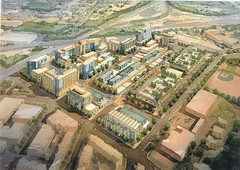
New Town at Capital City Market, rendering.
(Click here for scans of the brochure promoting the New Town proposal.)
Fortunately, there have been a number of articles in the press recently about the likely negative impact of this proposal. Harry Jaffe of the Examiner wrote two columns; "There’s a stench from Florida Avenue Market" and "Ethnic brigade rescues the Florida Avenue market," and the Examiner ran another article as well, "History, future of Capital City Market at a crossroads."
All along there are a few things that have really bothered me about the "New Town" proposal, which clearly has suburban office park and residential development architectural and design antecedents:
1. The Office of Planning Cluster 23 Plan, which proposed strengthening and extending the food-based character of the market, has been ignored.
2. And higher-level DC Government officials told the Office of Planning to keep quiet about this in the face of pressure from the New Town group, and its handlers.
3. A solicitation "to do something" at and to the Florida Market was never developed. This is commonly called a "Request for Proposals." NCRC and the Anacostia Waterfront Corporation do have open processes for communicating about development opportunities as well as selecting the developer, based on the proposals submitted. (Sometimes these processes can be quite open to public participation, such as NCRC's handling of the rebidding of the project at 5th and K Streets NW now under construction called City Vista.)
4. So City Council is taking action without there having been an open process for solicitation, and without a vetting and analysis of the proposal.
I can't think of government contracting practices that are much worse than these.
So it's difficult to state with much certainty that any of the claims by the group are believable. (At least I haven't seen the market study, and I don't know anybody who has.)
So claims on the brochure that:
The New Towns plan blends the best of the old with the best of the new. It is a public-private partnership, reflecting the idea of Ward 5 residents, existing Market entrepreneurs, and DC Government planners and policy-makers[.]
are troubling.
As are the omissions--what about current retail and wholesale customers, the businesses and institutions, in DC and the region, that rely on the market to supply their operations. And why are Ward 5 residents the only interest group of citizens here? Ward 6 abuts the market, and in fact, Ward 6 residents live closer to the Florida Market than anyone in Ward 5. But more importantly, the market is used by residents throughout the city and region, and a good plan, desiring success, would gather much more input than this one has.
But I will say that the development group is smart. Unfortunately, I can't find my copy of the first iteration of their publicly distributed brochure. It was awful, a suburban development plopped down in the heart of the city--a kind of visual pollution analogous to the Brentwood Shopping Center.
I just got a copy of the current brochure and it is much better. It's not absolutely terrible, and they have incorporated many of the arguments and examples made by people like me when we were saying that this development plan is flawed. (It's a classic example of the co-optation of counter-arguments.)
E.g., I have been saying that rather than redevelop, look at the successful revitalization projects around food and markets such as the Ferry Building in San Francisco. Look at what is now on the front page of the New Town brochure:
Together, we can create a world-class urban village, and a shopping and dining experience matching the greatness of Rome's shops at the renowned Spanish Steps and America's popular Union Square in New York, the Ferry Plaza Market in San Francisco, and Faneuil Hall in Boston.
This, from people who want a bowling alley in the Market, and being represented by people who brought the very suburban Brentwood Shopping Center to DC and to Ward 5.
While it is possible that the provision inserted into the bill by Councilmember Catania, that 50% of the property owners (who are subject to inducements, and who aren't necessarily the proprietors of businesses located in their spaces) have to approve this project within 120 days in order for it to go forward with city support, will doom the project, it still is troubling, and reflects a contracting and development perspective that typified the Barry Administration, and is a way of doing "business" that should have been repudiated a long time ago.
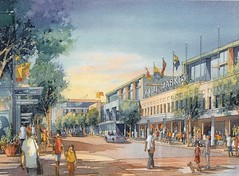
4th Street NE, view of revitalized buildings, New Town rendering.

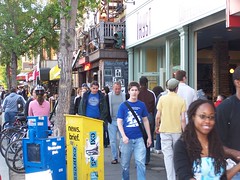
Sidewalk, Adams-Morgan (by Tryst).


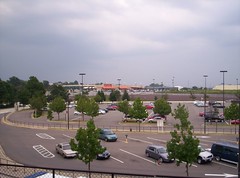
Rhode Island Place (formerly Brentwood Shopping Center) in Ward 5 in northeast Washington, DC, is a fundamentally suburban place, car-centric, within 1/4 mile of a subway station. This could have been a showcase by extending the urban fabric and creating a transit-oriented development, rather than merely being transit-adjacent.
Labels: food-agriculture-markets, urban design/placemaking, urban revitalization



0 Comments:
Post a Comment
<< Home